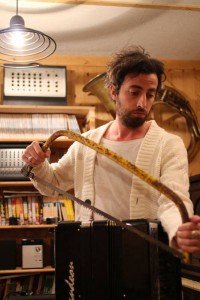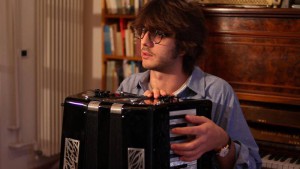 Last year we provided a detailed presentation of the Bercandeon, a free reed symmetrical instrument, with bellows and set on a tripod. Although it isn’t an accordeon, it shares some principles with it. A new model, called Bercandeon F, which is meant to satisfy the accordeonists’ needs (for example allowing the voices inside the resonance box) will soon be available.
Last year we provided a detailed presentation of the Bercandeon, a free reed symmetrical instrument, with bellows and set on a tripod. Although it isn’t an accordeon, it shares some principles with it. A new model, called Bercandeon F, which is meant to satisfy the accordeonists’ needs (for example allowing the voices inside the resonance box) will soon be available.
Meanwhile, we are going to report the impressions of two young musicians, who are using the traditional Bercandeon.
Alberto Bazzoli, pianist. Could you tell us something about your background as a pianist?
My training as pianist and hammond organist didn’t start with classical music but with the Afroamerican, such as blues and jazz. In the beginning I took private lessons and afterwards I attended the jazz course at the Academy of music in Ferrara, where I got my bachelor’s degree and where I am finishing my second year of master.
The passion for this music led me to play with important musicians in this sector, like J. Monque’d, Andy J. Forest, Little Paul Venturi, Vince Vallicelli, Massimo Tagliata, Massimo Sbaragli.
In the last year I have been interested in studying our roots in the early 20s Italian dancing music.
Therefore, I founded my band called Zombie Orchestra. We have released two Cds for the label Velut Luna: “Someone likes it Zombie- the sad story of a romantic orchestra” and “C’era una volta in Romagna- danze tribali del popolo del liscio”. In the last one I could record some tracks with the Bercandeon.
Gabriele Marangoni, accordeonist. Could you tell us about your musical background?
My musical training started with my approach to the accordeon and then developed into research and absolute sound. I got my accordeon degree at the Conservatory of Milan with M° Sergio Scappini and at the same time I got a university degree in science and technology of arts at the University of Turin. After university I devoted myself to the study of composition and electronic music, ending my training with the Master in Advanced Studies in Contemporary Music Performance and Interpretation at the Conservatory of Lugano, in Switzerland.
Alberto. What projects are you working on at the moment?
At the moment I’m a member of several bands (Alessandro Ristori and Portofinos, Mr. Zombie Orchestra, Collettivo Ginsberg, Little Paul Venturi & the Junkers, Sara Zaccarelli Soul Band) that range from blues/soul to the Italian music of the 60s and the more experimental original music.
Gabriele. What projects are you working on at the moment?
Currently, besides the Bercandeon, I am working on my new “solo” for accordeon, electronics and video, where the audience will enjoy the concert only in headphones. I am also writing a new piece of music for triple ensemble called “Chaos”. Both these projects respond to my need to search something, that fortunately I haven’t found yet and to expand my personal musical language.
I’m concentrating my aesthetics on the concept of chaos, I’m fascinated by the energy that it can produce and I believe that the sound is the ideal mean for building and achieving this. A chaos, which isn’t randomness but the key to access an altered state of conscience full of creative potential that will disorient the mind and break the strict patterns of thought. Abandoning yourself to chaos and sound means discovering your weaknesses and getting in contact with your intimacy.
Alberto. You have been using a Bercandeon in third with an incorporated microphone for more than a year. Do you remember your first impression?
Astonishment for this new, strange instrument. It was like seeing a unicorn. Nowadays, where nothing seems new, I’m always amazed by what human imagination can create. After that there was the difficulty in discovering how to play it. Obviously, its relationship with the accordeon and the piano can help us exploring it but I’m more and more convinced that it’s an instrument with its own peculiarities and that it requires a specific technique.
Gabriele. You have been using the Bercandeon in fourth for a couple of months: what is your first impression?
I was fascinated by the idea of symmetry and while playing it I was immediately aware that it had its own character and that it required to be accompanied in a particular dance, a linear movement that deeply affects the sound and the way of playing it. In my opinion it’s really important not to consider it in the shadow of the accordeon, but as an indipendent instrument that will have to develop its own identity and peculiarities.
Alberto. Tell us about the use of the left hand with the piano and with the Bercandeon?
What attracted me most was the freedom with which you could use your left hand. You can play narrow, dissonant chords like on a piano or, as I usually do, with much larger chords with the tenths to point out its wonderful voice on the deep, low notes.
Gabriele. The accordeon and the Bercandeon are both built with a bellow, but apart from that, there are a lot of differences in the way they are built and played. Can you tell us something about it?
The bellow is the heart of both the accordeon and the Bercandeon. For me the bellow is the real instrument and what is built around it is just there to allow to hear its voice. The Bercandeon has got two bellows, which are smalller than the accordeon’s ones and are played with a completely different technique. Consider that with the Bercandeon you must use your legs. As a consequence, you interact with the Bercandeon with less strength, less aggressiveness and you need a good coordination to play the two bellows in the best way possible, allowing you to create different dynamics between the two keyboards and different rythmical swing. Obviously, the presence of two keyboards and two handstrips makes the Bercandeon an original instrument. As an accordeonist, after years of playing the accordeon, I had to educate my left hand to play on a keyboard instead of using bottons.
Alberto. The instrument doesn’t have a handbook and I imagine you have created one of your own. Could you tell us something about it?
As I said before the instrument has its own identity and would need a particular way of learning. At first I just tried to transpose what I did with the piano on the Bercandeon and then I slowly started to explore it using a better polyphony between the parts, as if it was a harmonium and I must say that this is the best way to bring out its peculiarities.
Gabriele. The instrument hasn’t got any “literature”. Which is the most suitable repertoire in your opinion? What encouraged you to play it?
I find the fact that there is no literature interesting. This means the Bercandeon offers several possibilities of transcription and adaptation to different repertoires, according to the musician’s taste or need. As far as I’m concerned I find its slimmer, lighter nature, compared with the accordeon, very interesting. Its shorter breath has transmitted me a sort of intimacy. I’m working on some new compositions for Bercandeon and I realized that the instrument led me to a more medidative way of writing, more linear, more symmetrical than my usual production. This might be because I’ve just started to interact with this instrument, but I think it’s a nice start.
 Alberto. Your Bercandeon has an incorporated system of microphones that allows you to amplify it or to apply effects. Have you already tried this?
Alberto. Your Bercandeon has an incorporated system of microphones that allows you to amplify it or to apply effects. Have you already tried this?
I’ve tried to combine it with effects such as echo, tremolo and reverberation. Using it, as I have been doing recently, with a tape echo, the result is very interesting. I haven’t tried other effects, such as distorsions or the fuzz yet, but they could represent a new challenge.
Gabriele. Hearing you speaking about the double bellow and its use, I realize that the instrument might have unexpected similarities. I’m refering to the strings and the woodwind instruments, which can extend a note, but not as long as an accordeon or a harmonium. Do you think it could be compared with the pendular movement of the bow?
The movement of the two bellows can be compared with that of the bow, not as far as technique is concerned, but because the two bellows of the Bercandeon have a smaller opening than the bellow of the accordeon. Therefore the musician will have to pay a constant attention to the quantity of air and sound that are produced. The phrasing and the extended notes require a lot of care since the instrument doesn’t provide such a big reserve of air as in the accordeon.
Thank you for the attention. The next time we will be listening to you playing songs composed by Fiorenzo Bernasconi and the pianist Vito Maniscalco during the recording that will involve musicians who have tested or own a Bercandeon.
Questo post è disponibile anche in: Italian

 English
English Italiano
Italiano 





Leave a comment
You must be logged in to post a comment.